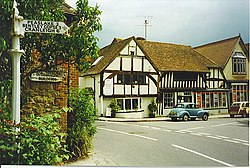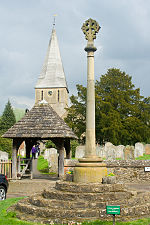Shere
| Shere | |
| Surrey | |
|---|---|
 Shere | |
| Location | |
| Grid reference: | TQ070479 |
| Location: | 51°13’14"N, 0°28’7"W |
| Data | |
| Population: | 0 |
| Post town: | Guildford |
| Postcode: | GU5 |
| Dialling code: | 01483 |
| Local Government | |
| Council: | Guildford |
| Parliamentary constituency: |
Mole Valley |
Shere is a village in Surrey. Shere has often been called one of the most beautiful villages in England; certainly few can surpass it in Surrey for a combination of those qualities that go to make up the ideal village. It sits in the valley of the Tillingbourne, one of a string of delightful villages in the valley of that brook beneath the scarp of the North Downs
Shere is about 6 miles east of Guildford and 4 miles west of Dorking. It is a small and attractive village in the traditional English sense. It has a small central cluster of old village houses, shops (including a blacksmith), tea house, art gallery, two pubs and a church. There is also a museum which opens most afternoons at weekends and the former Victorian fire station of 1886 (Grade II Listed and one of the oldest in Surrey) has been converted into public conveniences.
The Tillingbourne runs through the centre of the village, a small brook adding to the charm of the village to no small extent. The attractiveness of the village makes it popular with visitors from the benighted suburbs, which keeps the village shops busy.
Shere appears in Domesday Book of 1086 as Essira and Essire. It was held by the King. Its assets were: 1 church, 2 mills worth 10s, 14 ploughs, 3 acres of meadow, woodland worth 50 hogs. It rendered £15.[1]
Parish Church
The parish church is dedicated to St James and stands in the heart of the village, with the Tillingbourne running at its foot. It is of great antiquarian interest. The church has Norman roots, maybe even Anglo-Saxon. It has ancient brasses, door and font. It is built of Bargate rubble, with ironstone rubble, flints, and miscellaneous materials, some probably derived from Roman buildings on Farley Heath, the dressings being of Bargate stone, firestone and clunch, and the south and west porches are of brick and timber.
The church also has a curious and cruel reminder of earlier days in its fabric: a squint which is the remnant of an anchoress's cell. An anchorite in the old, unreformed Church, was an extreme form of hermit, walled up in a small cell with just a gap to receive food and a squint to see the mass performed in the church. The famous anchoress of Shere was one Christine daughter of William 'called the Carpenter' in the 14th century.[2] Confined at her own request, she later changed her mind and escaped, only to be dragged back and walled in the for rest of her life. It is a cruel tale for such a pretty village.
Appearance in film and books
- Hearts of the World (1918), a silent film by DW Griffith 1918 DW Griffith, featured Shere
- A Matter of Life and Death (1946) used Shere as Dr Reeve's village
- The Earth Dies Screaming (1965), an unsubtly named science fiction film, used Shere as a location
- The Ruling Class (1972) with Peter O'Toole was filmed here
- Bridget Jones: The Edge of Reason (2004) used Shere church briefly in the wedding scene at the end of the film
- The Wedding Date (2005) likewise
- The Holiday (2006) with Cameron Diaz, Kate Winslet and Jude Law was partly filmed in Shere
- The Anchoress of Shere by Paul L Moorcraft is a book set in Shere, weaving a story based on the true tale of Christine the runaway anchoress in the Middle Ages
Outside links
| ("Wikimedia Commons" has material about Shere) |
